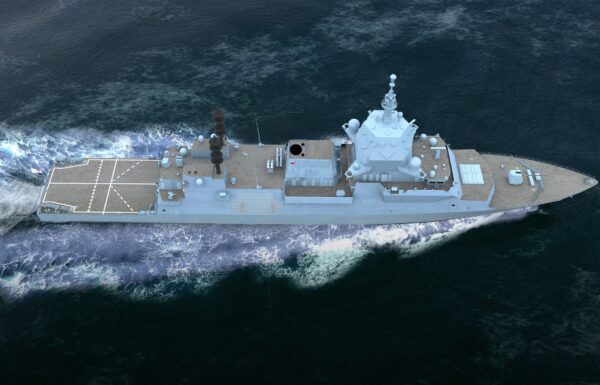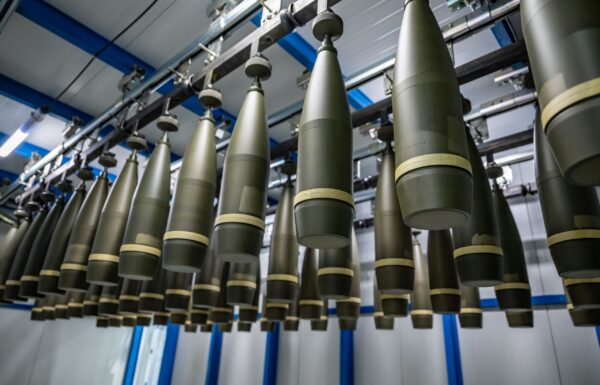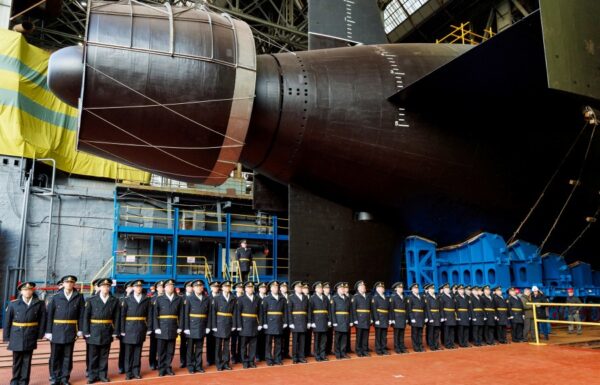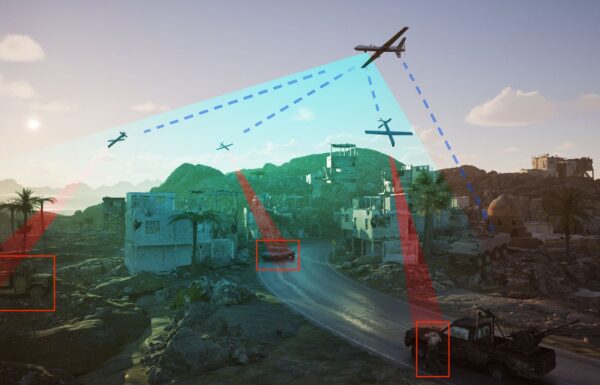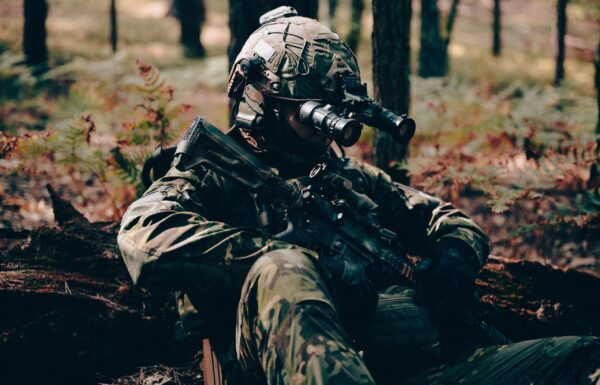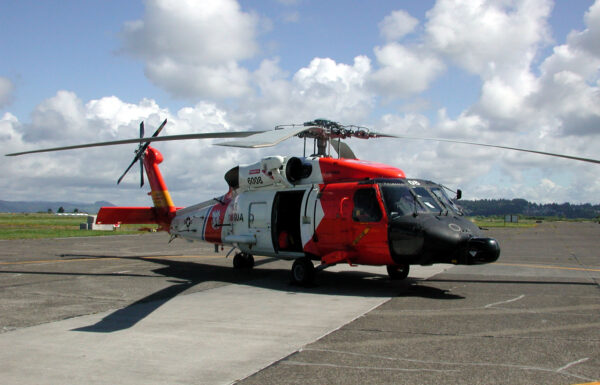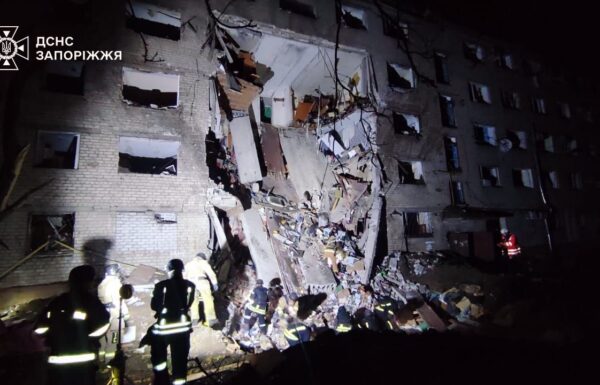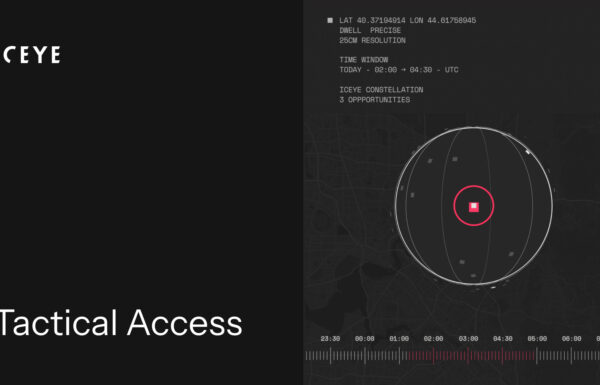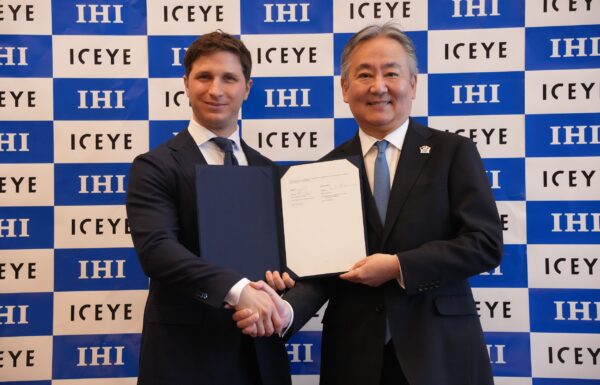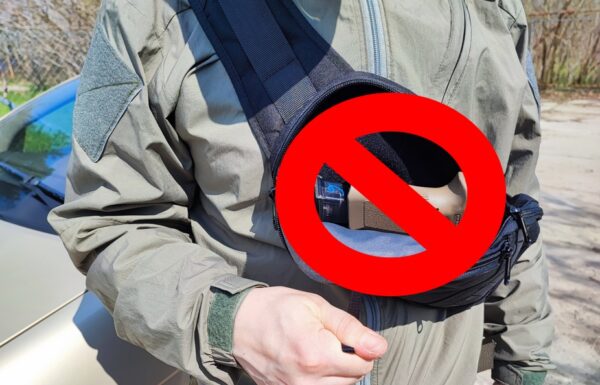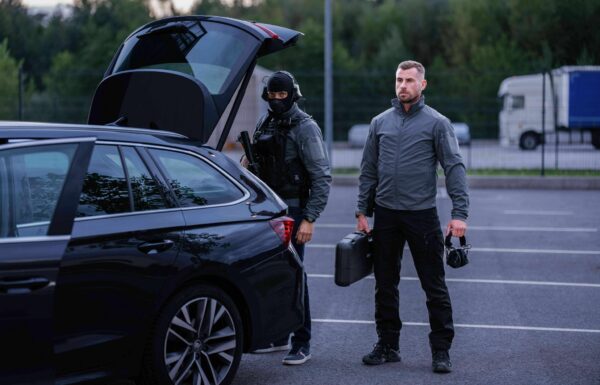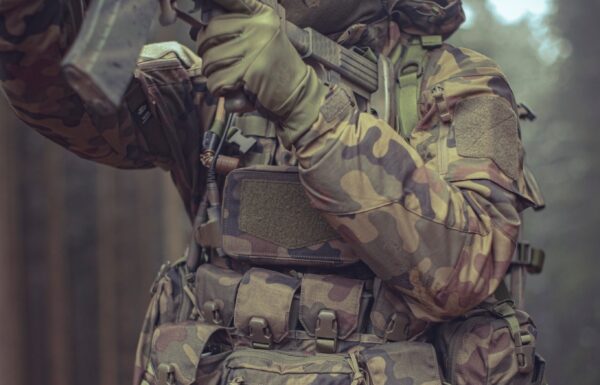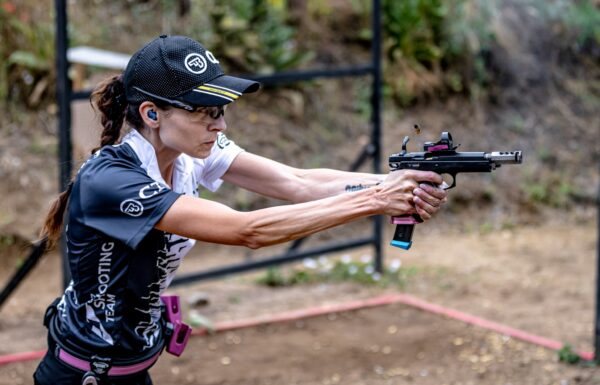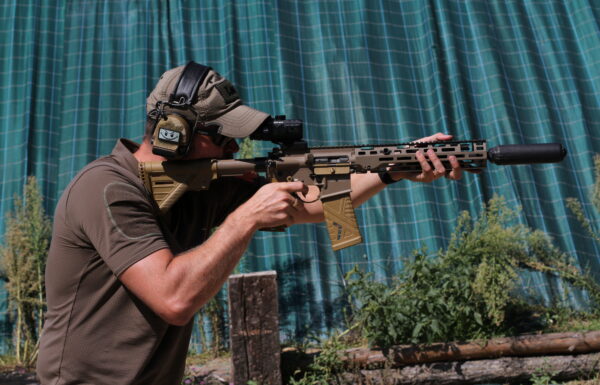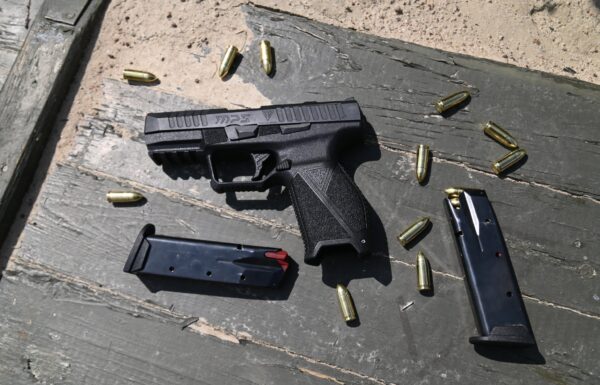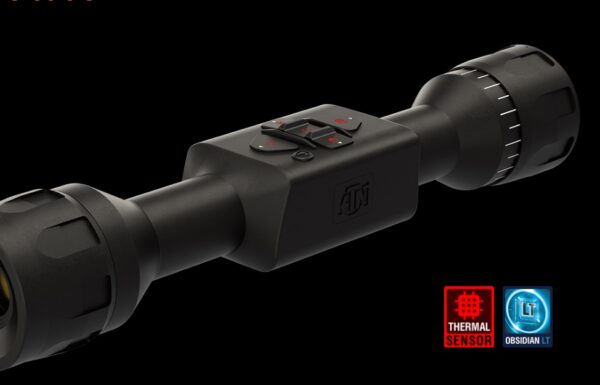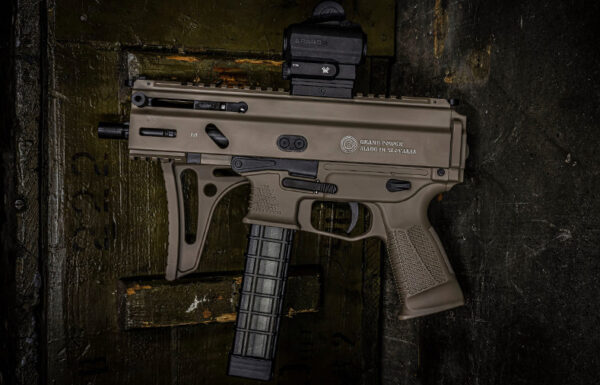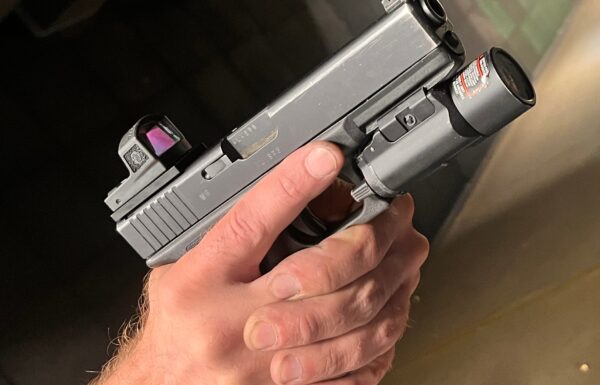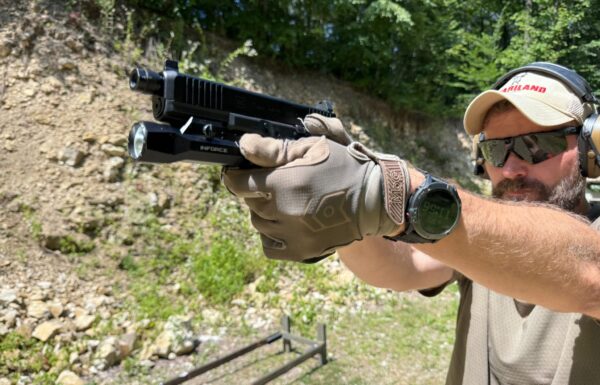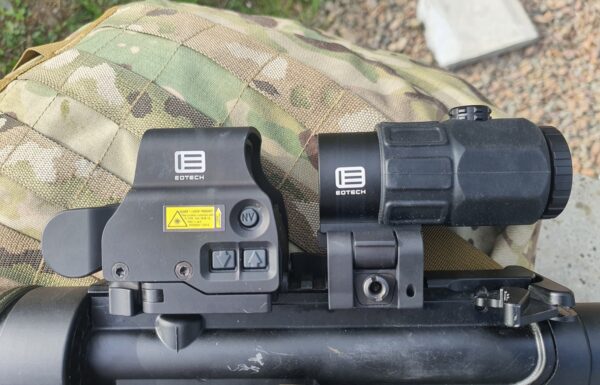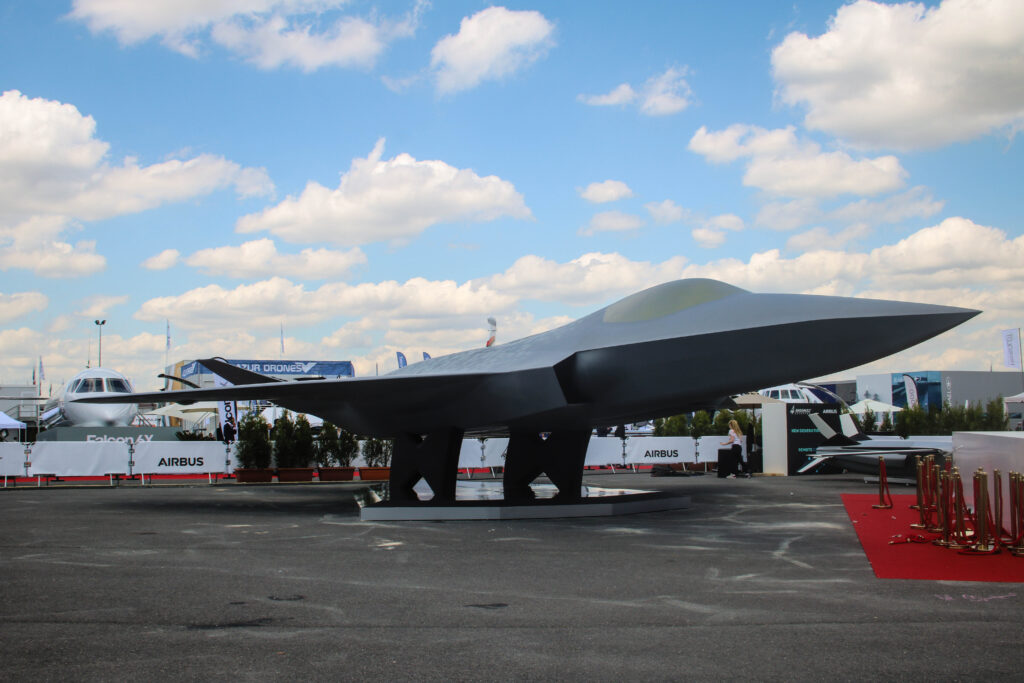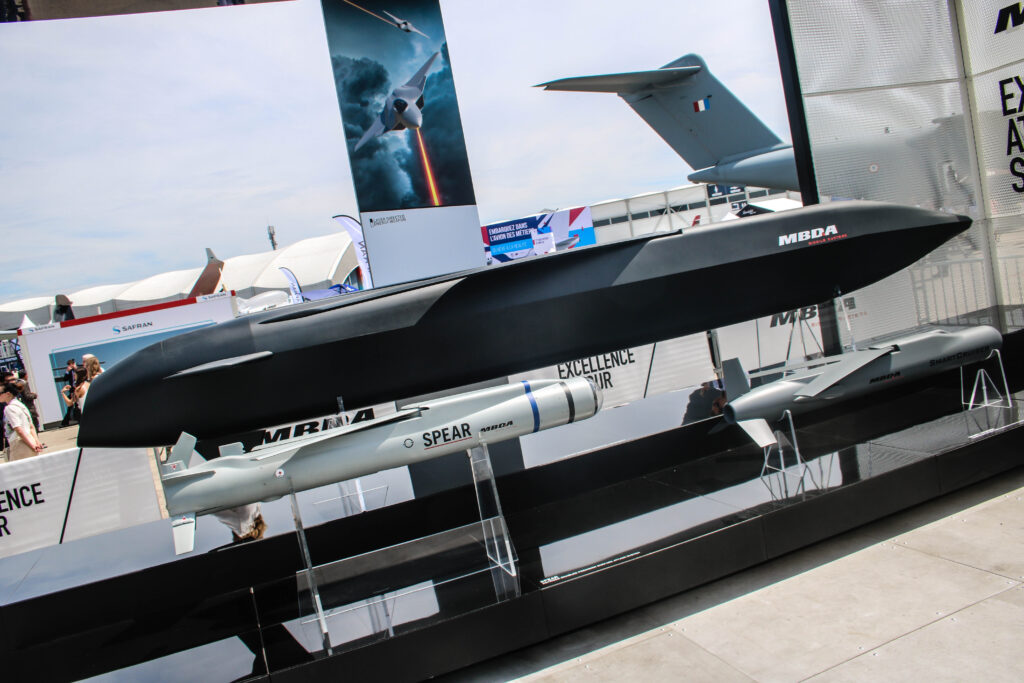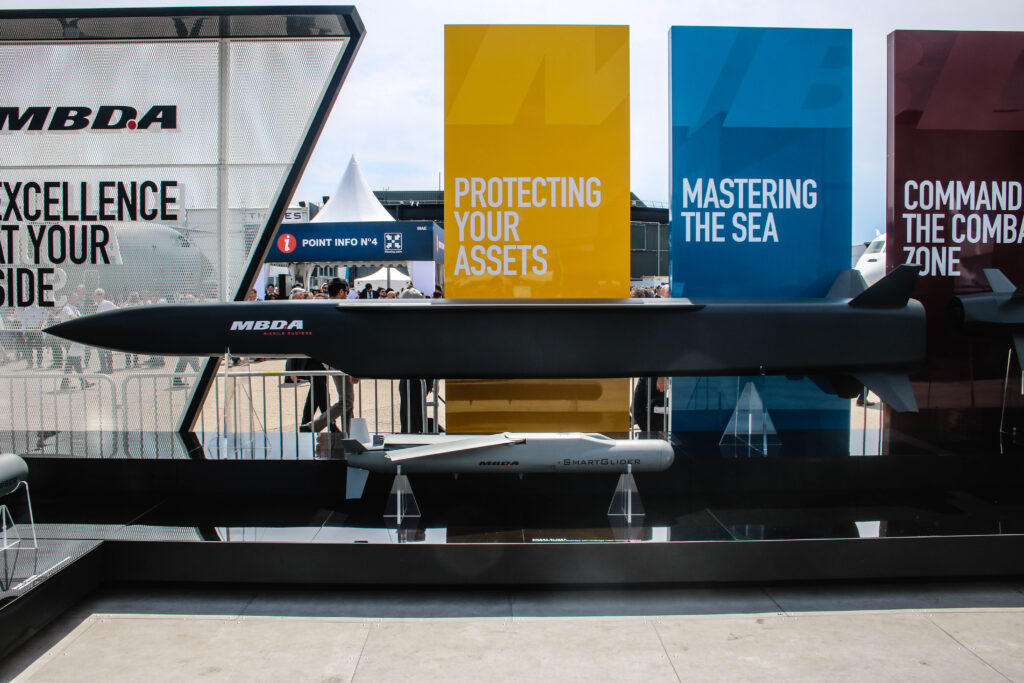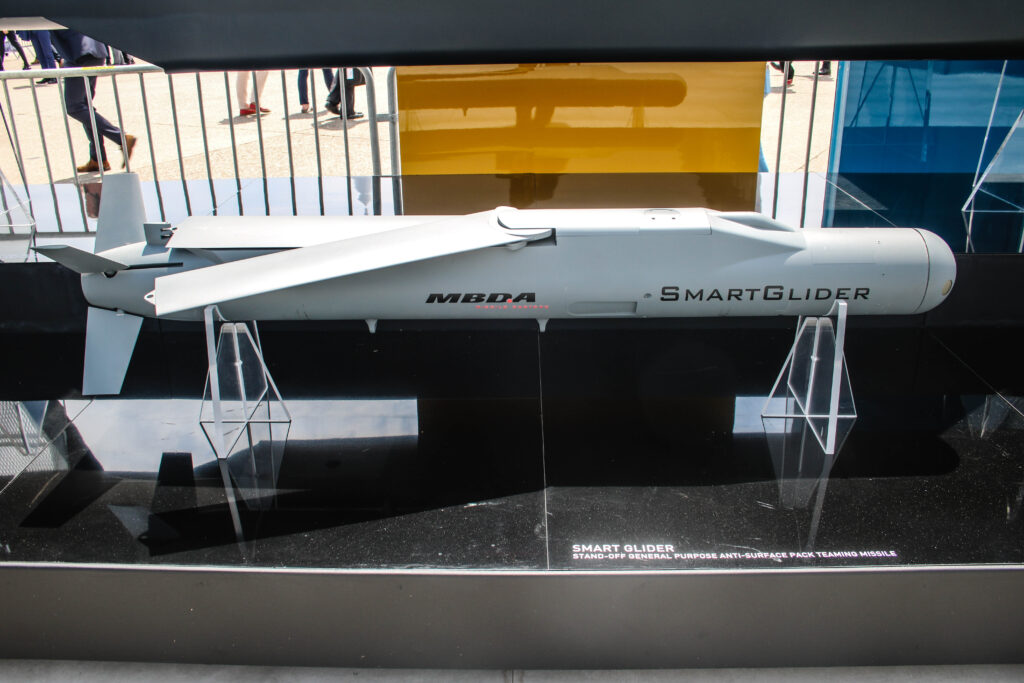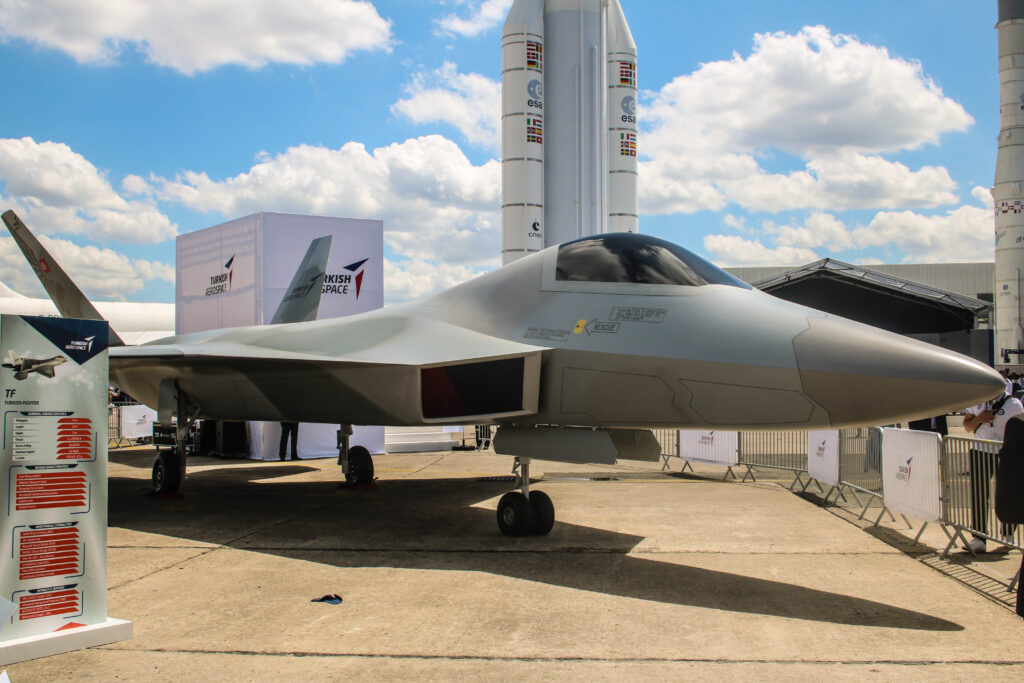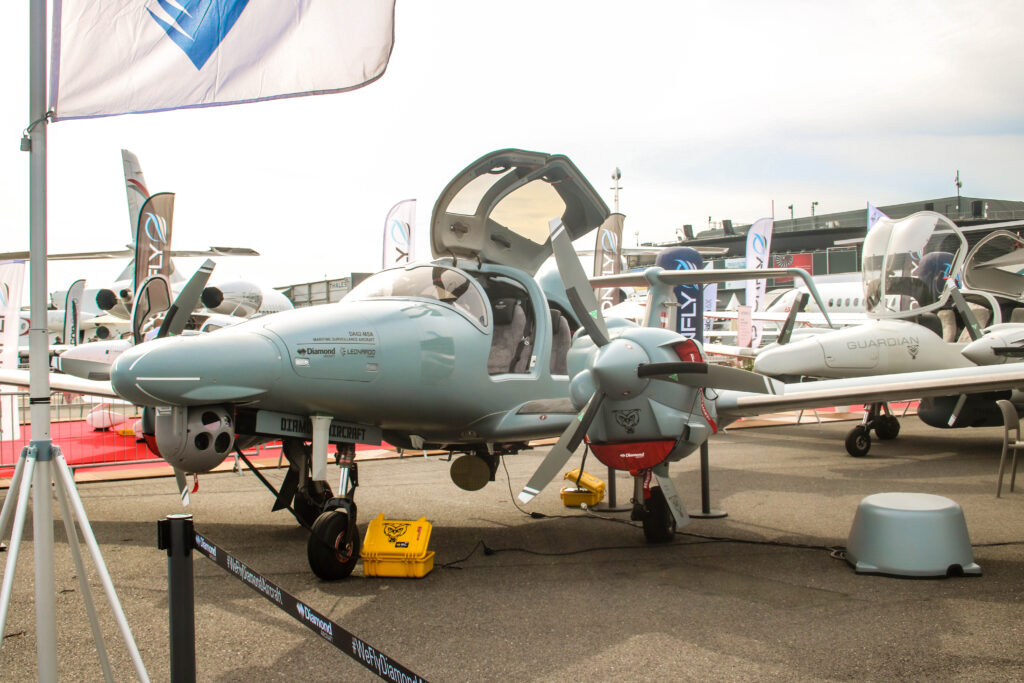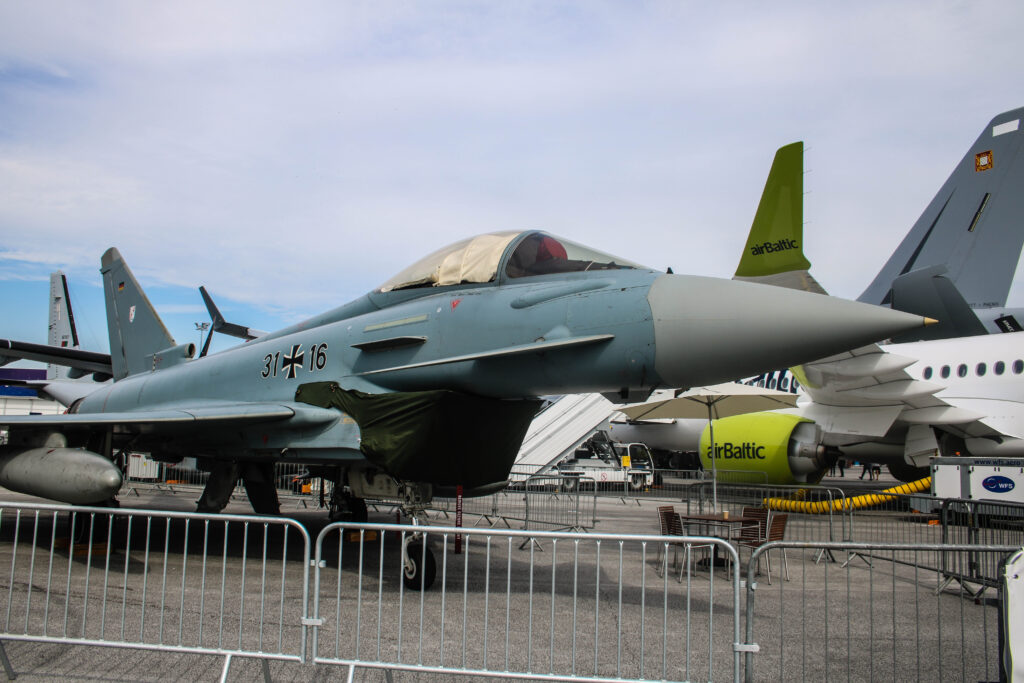The event was attended by over 316 000 visitors, including 140 000 professionals from nearly 190 countries. 2700 journalists from 87 countries accredited for the show. Approximately 140 vertical-lift and fixed-wing platforms were on the display at le Bourget. The agreements signed during the Paris Air Show were valued at $140 billion.
SCAF/FCAS presented
The French manufacturer Dassault Aviation and European Airbus Defence and Space presented at le Bourget a full scale model of the 6th generation multirole fighter jet SCAF/FCAS (Système de Combat Aérien du Futur/Future Combat Air System) and a number of auxiliary, combat unmanned aerial vehicles RC (Remote Carrier). The aircraft is developed as part of an offer for governments of France, Germany and Spain for the replacement of currently operated Rafale, Typhoon and C.15 Hornet fighters. The French president, Emmanuel Macron, was the guest of honor and was accompanied by the ministers of defence of all three countries: Florence Parly, Ursula von der Leyen and Margarita Robles, who signed a cooperation agreement.
The SCAF/FCAS project should conclude in 2021 and serve as a starting point for development of a new generation fighter aircraft NGF (New Generation Fighter). The programme will be commenced by Dassault, while Airbus will develop a fleet of auxiliary UAVs and an ACC (Air Combat Cloud), which will analyse all data gathered by the aircraft in real time, help the pilot in the decision making process and secure the platform from cyber threats. A number of other European manufacturers will be involved in the NGF programme, such as Safran or MTU Aero Engines, which will deliver NGF’s new engines. MBDA will be responsible for the development of platform’s combat systems and Thales will deliver avionics. NGF is expected to make a maiden flight by 2026. It should be ready to enter service in 2040’.
The FCAS programme has an estimated value of at least €4 billion. France is expected to contribute €2,5 billion and Germany €1,5 billion. At this moment it’s not sure, what financial contribution will be made by Spain, which has joined the project just lately, after months of negotiations.
MBDA unveils its vision of future air systems
MBDA presented at Paris Air Show technology demonstrators of new air-to-air and air-to-ground weapon systems, which could be applied for the SCAF/FCAS or Tempest next generation multirole fighter aircraft. Among systems on display were four missiles designed to operate in the Anti-access/Area-denial (A2/AD) environment.
The idea behind the development of these missiles was based on five requirements: deep strike capability, tactical-level engagement, medium- and long-range aerial warfare, soft- and hard-kill self-defence capabilities and capability to penetrate enemy airspace with the use of UAV platforms.
The MBDA’s presentation included weapon systems, which are something in between cruise missiles and UAVs. Remote Carrier 100 and Remote Carrier 200 have masses of, subsequently, 120 and 240 kg. They will be able to carry different types of warheads, including explosive, targeting, reconnaissance or EW. Remote Carrier 100/200 weapon systems will be carried and launched by the fleet of next generation fighter jets, and subsequently operate in swarms.
Another family of weapons presented at le Bourget were the two types of cruise missiles, each equipped with different propulsion systems. The low altitude Subsonic Cruise Missile is designed as the successor of the currently operated Storm Shadow/SCALP EG (SPEAR Capability 4) missile and will be used to attack ground or sea based targets deep behind enemy lines.
The Supersonic Cruise Missile was designed based on the experience from the CVS401 Perseus project. It could replace the ASMP-A (Air-Sol Moyenne Portée-Amélioré) missile, armed with a 300 kt nuclear warhead, in the French Armed Force’s inventory. Both cruise missile systems are predicted to replace RGM-84 Harpoon and MM38/MM40/AM39/SM39 Exocet missiles for France and Great Britain.
MBDA showcased also SmartGlider and SmartCruiser missiles. Both will be offered in the Light (120 kg) and Heavy (1300 kg) variant. A special HSL (Hexabomb Smart Launcher) launch system will allow for carrying 12-18 missiles in the Light version. The manufacturer is also working on a miniaturized, hard-kill missile system to enhance self-defence capabilities of the user’s aircraft platform. They will be less than 1 m long and weight under 10 kg. Other systems on MBDA stand included: AIM-132 ASRAAM, CAMM, Brimstone and SPEAR missiles.
TAI presents new fighter jet
For the first time ever the full scale mockup of the Turkish TF-X 5th generation multirole fighter jet was shown at the Paris Air Show 2019. The platform is being developed to meet the future requirements of the Turkish Air Force.
TF-X is developed by TAI and other local companies in response to the Turkish Air Force requirement for a new generation multirole platform, which eventually will replace the currently operated F-16 jets. However, it still remains unclear, what role will the TF-X play in regards to F-35A Lightning II jets, which Turkey was supposed to procure until the late political disrupt with the U.S. over the procurement by Ankara of the Russian S-400 air-and-missile defence systems.
According to the manufacturer, the TF-X will have a length of 21 m, wingspan of 14 m and height of 6 m. The aircraft should reach the max speed of 1,8 Mach and have a service ceiling of 55, 000 ft.
Platform’s design will be characterized by stealth, internal weapons bay, increased situational awareness, supercruise and sensor fusion. The first flight of TF-X’s prototype is planned for 2025. The platform should be commissioned in 2020’.
Falco Xplorer unveiled
During Paris Air Show Leonardo presented its newest and largest-ever drone, the FalcoXplorer. Presentation of Leonardo’s remotely-piloted air system opens new civil and military markets for the Italian company.
According to Leonardo, the newly presented Falco Xplorer features a payload capacity of 350kg, more than 24 hours flight time and a satellite communications capability for beyond-radio-line-of-sight operations, all within a 1.3 ton maximum take-off weight. Each element of the system, from unmanned platform to the sensor suite, mission system and ground control station, was developed by the company in-house.
‘Leonardo invests continuously in new capabilities to ensure we position the right products in the right markets’, said Leonardo CEO Alessandro Profumo during the presentation. ‘The Falco Xplorer is designed to be extremely competitive in its category, building on the experience we’ve gained working with Falco family customers over a number of years and our Company’s strengths in the unmanned domain. By understanding and being able to meet our customers’ needs, we expect to increase our share of the unmanned systems market’, he added.
Currently the Falco Xplorer is undergoing certification for flight in non-segregated airspace, allowing the platform to be sold on military and civilian markets. Aside from militaries, such institutions as coast guards and emergency responders, are mentioned as potential customers.
The manufacturer expects that Falco Xplorer will be ready for deliveries to first customers as early as 2020. It will be certified according to STANAG 4671, allowing it to be sold among NATO countries.
MCL for Hero-400EC
UVision Air unveiled at the Paris Air Show a Multi-Canister Launcher (MCL) for the Hero-400EC loitering munition system. According to the manufacturer, the MCL is suitable for a wide range of land and naval applications.
‘Hero-400EC is a long-range, high-precision loitering munition system with a low acoustic, visual and thermal signature that can locate, track and strike static and moving targets with high accuracy, stealth and minimal collateral damage. Precision strike capabilities, extended endurance of up to 2 hours, and multipurpose warhead ‒ including concrete piercing, anti-tank, and anti-personnel that handle different types of targets with exceptional accuracy ‒ enable long-range & versatile missions. Due to its exceptional manoeuvrability, Hero-400EC provides an advanced mid-air abort capability that allows automatic re-entry into loitering mode, re-engagement, or return to the recovery area using a parachute’.
Hero-400EC is a long-range and endurance weapon system, which weights 650 kg. It can be launched from a modular multi-tube canister mounted on various land or naval platforms and deployed in Forward Operating Bases.
SPICE-250 with AI
It was unveiled in le Bourget that Rafael Advanced Defense Systems concluded tests and demonstrations of a new ATR (Automatic Target Recognition) capability for its SPICE-250 air-to-surface munition, which adds to an array of technologies applied for this weapon system, such as Automatic Target Acquisition (ATA) and Moving-Target-Detection homing modes.
ATR enables the SPICE-250 weapon system to learn the characteristics of the target before the strike, thanks to the use of advanced AI and deep-learning technologies. The pilot makes the selection of targets which are supposed to be hit, and allocates them to particular missiles. Rafael states that subsequently ‘the weapons are launched towards the vicinity of the targets, using their INS for initial navigation. When approaching the target area, the weapons use the ATR mode for detection and recognition of the targets. Each weapon homes-in on the pre-defined target, either autonomously or with a human-in-the-loop, aided by the ATR algorithm’.
The family of SPICE (250, 1000, 2000) standoff, autonomous, air-to-ground missiles are designed to attack targets with pinpoint accuracy and at high attack volumes. The system can operate in GPS-denied environments. The particular SPICE-250 missile has a standoff range of 100 km, and can be equipped with either general purpose or penetration 75kg class warhead.
DA62-MSA revealed
Leonardo and Diamond Aircraft showcased at le Bourget the new DA62 MSA (Maritime Surveillance Aircraft) aircraft for the first time. It was designed to meet the requirements of clients, who look for an affordable Intelligence, Surveillance and Reconnaissance platform, capable of conducting short and medium range maritime and over-land surveillance missions. Among potential operators are countries in South America, Africa and Asia Pacific.
The aircraft is equipped with Leonardo’s Gabbiano Ultra-Light TS Radar, operating in various modes, a High Definition third-party Electro-Optic (EO/IR) system and Leonardo’s ATOS mission system, all fully integrated into the operator’s touchscreen ATOS display. As an option, the client can also require Leonardo’s SAGE ESM system and Spider communications intelligence system.
‘Diamond Aircraft is very proud to step into such an important strategic partnership with Leonardo to provide a cost-efficient, high-performance maritime surveillance solution to the market. We all recognized the importance of such a capability and the high demand of many countries to protect their borders against illegal fishing and other criminal operations. This new airborne solution, based on our DA62 Special Mission Aircraft, will be available to the market by the end of the year, ready to deliver and provide security and surveillance tasks’, said Liqun Zhang, CEO of Diamond Aircraft.
‘Partnership is central to Leonardo’s way of doing business and as such we are delighted to be working with Diamond Aircraft on this venture. Our aim is always to provide the optimum solution to our customers and we believe that this combination of Diamond’s platform with a full suite of Leonardo sensors and our mission system provides an extremely compelling offer for this market segment’, said Fabrizio Boggiani, Senior Vice President Airborne Sensors & Mission Systems, Leonardo Electronics.
Long Term Evolution of Typhoon
Eurofighter, Eurojet Turbo and the NATO Eurofighter & Tornado Management Agency (NETMA) have agreed on cooperation and support for the long-term development of the Eurofighter Typhoon combat aircraft.
The study contracts are worth EUR54 million. They will look at the Long Term Evolution of the aircraft and the EJ200 engine. Agreements will span a total of 19 months for the aircraft and 9 months for the engine elements.
According to Eurofighter, the LTE will identify ‘a suite of technology enhancements for the weapons system infrastructure and the engine that will ensure the aircraft remains operationally effective and can continue to spearhead the partner nations’ air forces for the decades to come’.
‘These contracts represent a significant step in shaping the future of Eurofighter and will ensure it continues to be one of the most important assets in the future operating environment’, said Herman Claesen, CEO of Eurofighter.
Under the LTE contracts a number of technology areas will be explored, such as: mission system architecture, the Praetorian Defensive Aids Sub-System, the human-machine interface, operational flexibility as well as engine performance.
Photos: Michał Jarocki
Article previously published on MILMAG 02/2019


